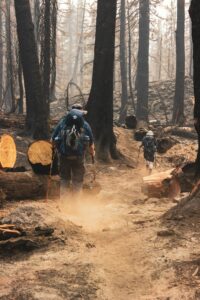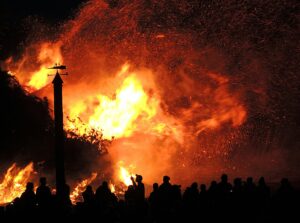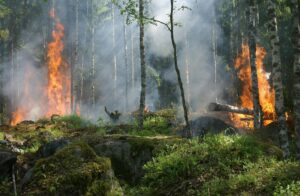
In recent years, California and Canada have experienced some of the most devastating wildfires in history, contributing not only to the destruction of homes and ecosystems but also to a surge in air pollution that has affected millions of people. The smoke from these fires has traveled across continents, polluting the air with dangerous levels of particulate matter (PM2.5) and other harmful pollutants. However, one question looms large: Could better forest management have prevented or at least mitigated these disasters?
Wildfires: A Growing Environmental Threat
Wildfires have always been a natural part of forest ecosystems, but in recent years, their frequency and intensity have increased dramatically. According to the National Interagency Fire Center (NIFC), wildfires burned through over 10 million acres in the U.S. in 2020 alone, and Canada saw similar devastation. This rise in fire activity has been linked to a variety of factors, including climate change, but one often-overlooked issue is forest management—or the lack thereof.
Forest Mismanagement: A Catalyst for Disaster
For decades, many environmental policies have focused on preserving forests in their natural state, promoting the idea that “letting nature take its course” is the best approach. While this might sound like a noble goal, the reality is that unchecked forest growth, combined with a lack of active management, has turned many forests into tinderboxes just waiting for a spark.
Proper forest management includes practices such as:
- Thinning dense forests to reduce the amount of fuel available for fires.
- Prescribed burns to safely reduce underbrush and prevent larger fires from spreading.
- Clearing dead trees and other debris that can act as kindling.
- Creating firebreaks to stop the spread of fire to populated areas.
In many regions, these practices have been either scaled back or abandoned entirely due to environmental policies that prioritize conservation over prevention. While well-intentioned, these policies have contributed to an unnatural accumulation of fuel in forests, setting the stage for the massive wildfires we’ve seen in recent years.
The Environmental Impact of Wildfire Smoke
 The immediate destruction caused by wildfires is devastating, but the long-term environmental effects, particularly those related to air pollution, are equally concerning. Wildfire smoke is a complex mixture of gases and fine particles released when organic materials like trees, shrubs, and grasses burn. The smoke contains several harmful pollutants that have significant impacts on both human health and the environment.
The immediate destruction caused by wildfires is devastating, but the long-term environmental effects, particularly those related to air pollution, are equally concerning. Wildfire smoke is a complex mixture of gases and fine particles released when organic materials like trees, shrubs, and grasses burn. The smoke contains several harmful pollutants that have significant impacts on both human health and the environment.
1. Particulate Matter (PM2.5): The Silent Killer
One of the most dangerous components of wildfire smoke is particulate matter (PM2.5). These particles are less than 2.5 micrometers in diameter—small enough to penetrate deep into the lungs and even enter the bloodstream. The health risks associated with PM2.5 exposure are severe, including respiratory issues, cardiovascular problems, and even premature death.
When wildfires burn, they release enormous quantities of PM2.5 into the atmosphere. For example, during the 2020 California wildfires, air quality monitoring stations across the western United States recorded PM2.5 levels that far exceeded safe limits. In some cities, the air quality index (AQI) reached hazardous levels, forcing residents to stay indoors to avoid breathing in the dangerous smoke.
Long-term exposure to PM2.5 has been linked to an increased risk of chronic respiratory diseases like asthma, bronchitis, and chronic obstructive pulmonary disease (COPD). Vulnerable populations, such as children, the elderly, and individuals with pre-existing health conditions, are especially at risk. According to the World Health Organization (WHO), fine particulate pollution is responsible for millions of premature deaths globally each year, and wildfires contribute significantly to these figures.
2. Carbon Dioxide (CO2): A Greenhouse Gas with Far-Reaching Consequences
Wildfires release carbon dioxide (CO2), a well-known greenhouse gas, into the atmosphere. Forests typically act as carbon sinks, meaning they absorb CO2 from the atmosphere and help mitigate climate change. However, when forests burn, the CO2 stored in trees and other vegetation is released back into the atmosphere, contributing to the overall increase in greenhouse gas concentrations.
During the California wildfires of 2020, it’s estimated that the fires released over 90 million metric tons of CO2 into the atmosphere, roughly equivalent to the annual emissions of 20 million cars. The release of such large quantities of CO2 accelerates climate change, creating a feedback loop in which rising temperatures and changing weather patterns make future wildfires more likely and more severe.
3. Methane (CH4): A Potent but Overlooked Pollutant
In addition to CO2, wildfires also release methane (CH4), a greenhouse gas that is more than 25 times as effective at trapping heat in the atmosphere over a 100-year period compared to CO2. Although methane is present in smaller quantities than CO2, its high global warming potential makes it a significant contributor to climate change.
Methane is typically produced during the smoldering phase of a wildfire, when organic material is burned inefficiently. In areas where wildfires burn through peatlands, for example, methane emissions can be particularly high. Peat, which is made up of decomposed plant material, stores large amounts of carbon and releases both CO2 and methane when it burns.
4. Carbon Monoxide (CO): Immediate Health Risks
Carbon monoxide (CO) is another harmful gas emitted during wildfires. It is a colorless, odorless gas that can be lethal at high concentrations. Although CO dissipates relatively quickly in the atmosphere, it poses a serious health risk to individuals who are close to the fire or in areas where air circulation is poor.
Inhaling carbon monoxide reduces the blood’s ability to carry oxygen to vital organs, leading to symptoms such as dizziness, headaches, and, in extreme cases, death. First responders, firefighters, and residents in close proximity to wildfires are particularly vulnerable to CO poisoning.

5. Volatile Organic Compounds (VOCs): Creating Ground-Level Ozone
Wildfires also release volatile organic compounds (VOCs), which can react with nitrogen oxides (NOx) in the presence of sunlight to form ground-level ozone, a key component of smog. Ground-level ozone is not only harmful to human health—causing respiratory issues and exacerbating conditions like asthma—but it also damages crops and other vegetation, leading to reduced agricultural yields and harm to ecosystems.
6. Nitrogen Oxides (NOx): A Double Threat
Nitrogen oxides (NOx) are another group of pollutants emitted during wildfires. NOx gases contribute to the formation of both ground-level ozone and fine particulate matter (PM2.5), exacerbating the overall air quality crisis during wildfire events.
NOx emissions also play a role in the nitrogen cycle, contributing to acid rain and nutrient deposition that can harm ecosystems. Acid rain, in particular, has detrimental effects on forests, freshwater ecosystems, and soils, further complicating the recovery process for areas affected by wildfires.
7. Black Carbon (Soot): A Global Climate Forcer
Black carbon, commonly referred to as soot, is a type of particulate matter produced during the incomplete combustion of organic materials. It absorbs sunlight and heats the atmosphere, making it a powerful short-term climate forcer. Black carbon can also settle on snow and ice, reducing their reflectivity (albedo) and accelerating the melting process. This is particularly concerning in regions like the Arctic, where wildfires are becoming more frequent.
The deposition of black carbon on ice and snow contributes to a feedback loop in which melting ice exposes darker surfaces underneath, which absorb more sunlight and heat, leading to further melting. This process has a direct impact on global sea levels and contributes to the loss of polar habitats. The United States Geological Survey (USGS) discusses black carbon’s influence on global climate patterns.
8. Perfluorocarbons (PFCs): Lesser-Known, Long-Lasting Pollutants
Although not as commonly discussed as other wildfire pollutants, perfluorocarbons (PFCs) are released when fire retardants and firefighting foams are used to control wildfires. These chemicals are highly resistant to degradation and can persist in the environment for decades, accumulating in soil, water, and even in the tissues of wildlife and humans.
PFCs have been linked to serious health concerns, including cancer, liver damage, and developmental issues. Their long-lasting nature makes them particularly concerning as a pollutant in areas repeatedly affected by wildfires.
The Global Impact of Wildfire Emissions
Wildfire smoke doesn’t just stay in the area where the fire occurs. Depending on weather patterns, smoke can travel thousands of miles, affecting air quality far from the fire’s origin. In 2023, smoke from Canadian wildfires caused hazardous air quality in New York City and other parts of the northeastern United States. Similarly, wildfires in the western U.S. have sent smoke as far as Europe in recent years.
The widespread distribution of wildfire emissions has both immediate and long-term consequences. In addition to the public health risks associated with PM2.5 and other pollutants, the release of greenhouse gases like CO2 and methane contributes to global climate change, which in turn creates the conditions for more frequent and intense wildfires.
Conclusion: A Call for Smarter Forest Management
The devastating wildfires in California and Canada are a stark reminder that current environmental policies, particularly those focused on conservation at the expense of active forest management, are not enough to protect us from future disasters. While climate change undoubtedly plays a role in increasing the severity of wildfires, it is crucial to recognize that human decisions—especially those related to forest management—are also to blame.
To prevent future wildfires and the pollution they bring, policymakers must embrace a more proactive approach to forest management. This includes thinning overgrown forests, conducting controlled burns, and clearing dead trees and debris. By taking these steps, we can reduce the risk of catastrophic fires and protect both our environment and public health.
It’s time to recognize that forest management isn’t just about conserving trees—it’s about safeguarding our air, our health, and our future.
References:
- World Health Organization (WHO) – Ambient (outdoor) air quality and health
- National Interagency Fire Center (NIFC) – Wildfire Statistics and Reports
- Environmental Protection Agency (EPA) – Understanding Global Warming Potentials
- United States Geological Survey (USGS) – Black Carbon in Climate Science


